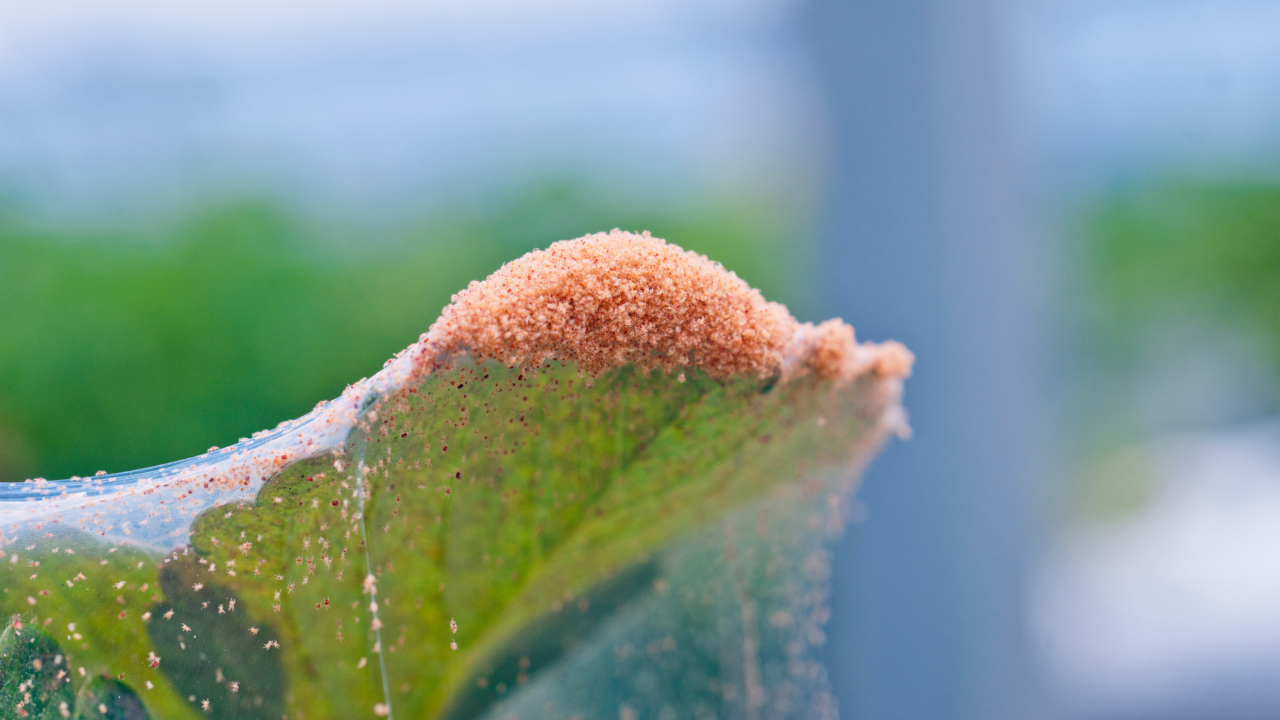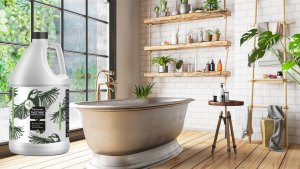Spider mites are a common pest that plague a variety of crops: peppers, potatoes, corn, cannabis, strawberries, melons, ornamental flowers/houseplants, and trees to name a few. Spider mites belong to the family, Tetranychidae, which is made up of over 1,200 different species; however, one of the most common species is the two-spotted spider mite. In this article, we will briefly discuss spider mite biology and outline a comprehensive Intelligent Pest Management® program to protect one’s plants without using harmful pesticides.
Table of Contents:
Spider Mite Biology & Life Cycle
IPM Program
Final Thoughts
Spider Mite Biology & Life Cycle
Spider mites belong to class Arachnida – making them related more to spiders and ticks, rather than insects. They live in colonies and tend to congregate on the undersides of leaves, however, will be found scouring for feedings sites all over the plant. Often their infestations will be accompanied by thick webbing.
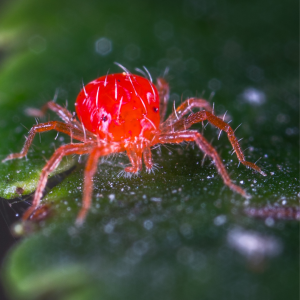
Spider mites come in a variety of colors but some of the most common are translucent or reddish brown or red, but some can be white or green. Adults have 8 legs and a piercing mouthpart, are oval-shaped, and nearly microscopic. They have 3 distinct life stages: egg, nymphal, and adult. Eggs are colorless or white, nymphs emerge with 6 legs and gain the total 8 when they become adults.
Spider mites produce rapidly and, under optimal conditions, only take 5 days to become sexually mature. A single female can lay around 20 eggs per day, allowing for the creation of entire generations in a short span of time. Optimal conditions include dry, hot conditions 80 F (27 C). *NOTE* The largest outbreaks occur after spraying synthetic pesticide poisons – these work to eliminate their natural predators and eliminating the weaker spider mites, developing rapid resistance to chemicals for new generations (rapid form of natural selection, “pesticide selection”).
IPM Program
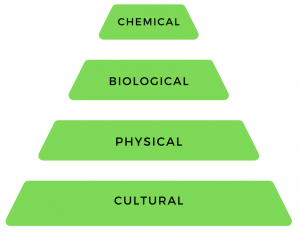
Every successful IPM program consists of 4 steps, that are to be completed in order from: cultural/sanitation, physical/mechanical, biological control, ending with chemical control (see IPM pyramid). The Author does not recommend the use of any chemicals and instead uses natural, safe Pestisafes®.
Cultural Control
This step consists of preventative actions that can be taken, often in the form of proper sanitation. Frequent, light watering can help to limit their attacks during hot, dry conditions (they especially hate cold water). Make sure to clean up and dispose of litter that clutters at the bottom of plants. Essential oils (oregano, tansy, basil oil, 2% emulsified avocado, anise, or cumin) can be sprayed to repel or eliminate them.
For inspection: take a white sheet of paper and hold it at the bottom of the plant. Gently tap the plant and look on the paper for moving red or black dots – use a magnifying glass to inspect closer. Look for their webbing around the plant. Feeding marks appear in yellow or white speckles on leaves and develop into bronze sheens.
When introducing new plants or clones to either indoor or outdoor growing facilities make a tub of soapy water, or better yet a tub of diluted TweetMint® Plant Wash at 0.5 oz (15 ml) per gallon, and simply dip each plant into the solution. This will eliminate any “hitchhikers”.
Finally, use a preventative/maintenance spray of TweetMint® Plant Wash at 0.5 oz (15 ml) per gallon weekly or biweekly.
Physical Control
Spider mites can be simply vacuumed up using a dusting brush attachment. Make sure to take a small pinch of food-grade diatomaceous earth (DE) and place into the vacuum bag, this will eliminate any spider mites that are sucked up.
Forceful sprays of cold water directed at the undersides of leaves, in early morning, will remove pests; repeat for 3 days.
Biological Control
Predatory mites, of the family Phytoseiulus persimilis, ladybugs, green lacewings, gall midges, and some pirate bugs will all hunt & control spider mites. It is important to introduce these predators early on, as they are less effective against larger spider mite infestations.
Pestisafe® Control
There are many natural, safe alternatives to use for spider mite control. DIY recipes can be made: dormant oil or garlic/pepper tea and liquid seaweed or 1/2 cup buttermilk/3 1/2 cup wheat flour and 5 gallons of water. Or take 1 oz (30 ml) of salt in 1 gallon of water and spray plants.
For the Best Control: Use TweetMint® Plant Wash, it is super-concentrated as it only takes 0.5 oz (15 ml)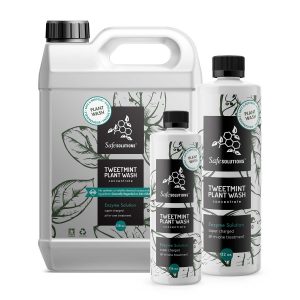 per gallon of water (light dilution) to control spider mites. It leaves no residual – once it dries it is gone. This means it will not affect plant taste/smell and when dried, it will be safe for pollinators.
per gallon of water (light dilution) to control spider mites. It leaves no residual – once it dries it is gone. This means it will not affect plant taste/smell and when dried, it will be safe for pollinators.
*NOTE* Anecdotal tests have shown that TweetMint® has not harmed predatory mites in some instances – further studies should be conducted. At that light dilution, TweetMint® will not harm larger insects i.e. the predatory ladybugs.
TweetMint® will eliminate spider mites at any stage in the life cycle, including their eggs. This has been observed under microscope as treated eggs turn from colorless or white to brown or grey.
If you want more of a lasting control/silica, add a teaspoon of DE to the TweetMint® solution and the DE will remain until heavy rains (for outdoor grows) or continual watering (for indoor grows) washes it away.
Application: Do not spray under hot lights or in direct sun, try to spray early morning or late evening – out of the heat of the day. Spray 3-4 days per week (or every other day), or as often as needed.
Final Thoughts
Spider mites seem to thrive when sprayed with synthetic pesticide poisons! It is important to use non-toxic, Pestisafes® and Intelligent Pest Management® to not harm you, your loved ones, or our shared environment.
For more information visit: www.thebestcontrol2.com
If you are interested in sustainable alternatives:
Order your own bottle of TweetMint Plant Wash here: https://www.safesolutions.com/product/tweetmint-plant-wash/
Call: +1(616)-677-2850
Email: gage@safesolutions.com
– Gage

